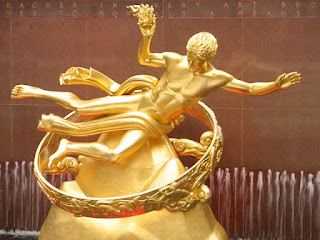Faience-bead broadcollar necklace from the reign of Akhenaten - 18th Dynasty
Image courtesy of: http://www.flickriver.com/
The ancient Egyptians were known for their love of vibrant colours - remnants of pigments can still be discerned in crevices of ancient statuary as well as on inaccessible parts of temples such as the uppermost parts of walls and pillars - and that love of colour is evident in personal items such as jewellery, protective amulets and funerary items known as ushabti, those figures placed in tombs specifically to carry out the deceased's wishes and instructions in the afterlife, thereby sparing the person the necessity of having to perform the tasks of labour for themselves.
Engraved faience bead from the reign of Amenhotep III
Image courtesy of: http://www.ganoksin.com/
Named "tjehnet" by the ancient Egyptians - meaning that which is scintillating or brilliant - faience is a glass-like, non-clay based ceramic substance dating back at least 5,000 years in history, consisting of common materials abundantly found in Egypt: ground quartz or sand with small amounts of calcite lime, crushed quartz pebbles, flint, a soluble salt-like baking soda and ground copper. The dried, pale and essentially colourless objects were placed into kilns and fired; the vitrified end-product emerged as a lustrous object in what is called "Egyptian blue." To the Egyptians, who deduced meaning in virtually everything around them, faience or tjehnet symbolized rebirth, with objects harbouring the eternal light of the heavenly bodies: stars, moon and the sun; it was associated with the colour of the sky, abode of the gods. In the 26th Dynasty (the Saite Period), referred to as the Egyptian Renaissance period, another particularly popular coloured glaze - green - was produced, the hue of which evoked the regenerative waters of the life-producing Nile and its surrounding verdant landscapes. (Source: miniatureancientart.com, undated)
New Kingdom Sphinx of Amenhotep III, 18th Dynasty - ca. 1390-1352 BCE
The above two images are courtesy of: http://www.metmuseum.org
It not being made of clay, it is ascribed as Egyptian faience to distinguish it from regular faience, tin-glazed pottery which is ordinarily associated with Faenza, produced in northern Italy. The popularity of faience in Egypt was its practical purpose of reproducing (and substituting for) the favoured colours of such costly gemstones as lapis-lazuli imported from Afghanistan and turquoise, mined in the Sinai peninsula. (Source: encyclopeida.thefreedictionary.com, 2010)
Its manufacture and affordability probably meant that most people were able to not only possess molded and magically inscripted objects associated with the (protective powers and colours of) gods, but also objects made for personal adornment such as beaded jewellery - necklaces and rings - or beaded, multi-coloured broadcollars and pectorals.
Faience and carnelian bead necklace - ca. I BC-IV AD
Image courtesy of: http://www.ancienttouch.com/
Sketch of a faience-bead collar from the Amarna Period - ca. 1379-1362 BCE
Patterned on organic collars originally made of lotus flowers, petals, cornflowers, dates and lotus-seed pods, these faience collars - less expensive to produce than those made with real gemstones - were often bestowed as gifts to banquet and/or wedding guests.
Image courtesy of: http://www.ezakwantu.com
Amulet of Isis suckling Horus - Ptolemaic Period, ca. 304-30 BCE
Amulet of the goddess Taweret, protectress of pregnant women
Ptolemaic Period, ca. 304-30 BCE
A lotiform cup - 22nd Dynasty, ca. 945-715 BCE
Statuette of a hippopotamus, painted with river plants, 12th Dynasty - ca. 1981-1885 BCE
The four images above are courtesy of: http://www.metmuseum.org
This monumental sceptre is the largest known example of Egyptian faience - ca. 1427-1400 BCE
Symbolic of power, this sceptre was found in fragments in a temple
Eye of Horus amulet, symbol of power and protection - ca. 1075-945 BCE
The above two images are courtesy of: http://www.vam.ac.uk
The sacred Eye of Horus amulet
Image courtesy of: http://www.biblicalantique.com
An amulet of Thoth as a sacred ibis and Maat
Ca., 664-332 BCE
Amulet of Sekhmet enthroned, ca. 6th-4th century BCE
The above two images are courtesy of: http://miniaturesinancientart.com/
Ushabti - Lady of Sati, New Kingdom, ca. 1390-1352 BCE
Image courtesy of: http://encyclopedia.thefreedictionary.com
Ushabti made for Psamtik, 26th Dynasty - ca. 570-526 BCE
Image courtesy of: http://www.safani.com/
Scarab faience ring
Image courtesy of: http://www.trocadero.com
Scarabs from the Annenberg collection
Scarab with separate wings, 25th-30th Dynasty - ca. 712-342 BCE
Winged scarab, 23rd-25th Dynasty
The three images above are courtesy of: http://user.adme.in
Pectoral of Senusret II, 12th Dynasty - ca. 1897-1878 BCE
Found in the tomb of his daughter, Sit-Hathor Yunet - a mixture of precious materials and faience
Image courtesy of: http://www.ishtarsgate.com
Tutankhamun's Udjat Eye (Eye of Horus) pectoral
Image courtesy of: http://www.touregypt.net
Tutankhamun's pectoral, late 18th Dynasty - ca. 1550-1292 BCE
Image courtesy of: http://user.adme.in/
Tutankhamun's Kheper Scarab pectoral
Image courtesy of: http://www.touregypt.net
With the discovery of Tutankhamun's tomb on November 26th, 1922, a new craze for Egyptian decorative designs was ignited. Prestigious jewellery houses, such as Cartier, launched closely-based designs strongly influenced by ancient artifacts or, in some instances, cleverly refashioned ancient fragments - such as scarabs, for instance - into modern jewellery.
Mrs. Cole Porter's Scarab buckle-brooch - Cartier, 1924
Image courtesy of: http://genevaanderson.wordpress.com
Suggested readings:
Egyptian Faience: The First High-Tech Ceramic (1987), by Pamela B. Vandiver: American Ceramic Society
Egyptian Faience and Glass (1993), by Paul T. Nicholson: Shire
Gifts of the Nile: Ancient Egyptian Faience (1998), by Florence D. Friedman, Georgina Borromeo & Rhode Island School of Design: Thames & Hudson
Eternal Egypt: Masterworks of Ancient Art from the British Museum (2001), by Edna R. Russman, Thomas G. Henry James & The British Museum: University of California Press























































































